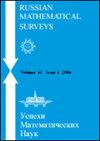相依随机变量三角形阵列的极值理论
IF 1.4
4区 数学
Q1 MATHEMATICS
引用次数: 2
摘要
Gnedenko[1]证明的极值理论的中心结果分类了独立同分布随机变量样本的归一化极大值可能具有的所有类型的渐近分布。如果变量不是同分布的或是相依的,类似的结果成立吗?我们考虑一个随机向量序列Xn=(X1,n,…,Xd,n)∈R,其中d=d(n)∈n,n∈n。设[d]:={1,…,d}。如果,对于任何固定的x∈R,Ş⏵ŞP(max i∈[d]Xi,n⩽x→ 0,作为n→∞, (1)本文章由计算机程序翻译,如有差异,请以英文原文为准。
Extreme value theory for triangular arrays of dependent random variables
The central result of extreme value theory proved by Gnedenko [1] classifies all types of asymptotic distributions that the normalized maximum of a sample of independent identically distributed random variables could possibly have. Does a similar result hold if the variables are not identically distributed or are dependent? We consider a sequence of random vectors Xn = (X1,n, . . . , Xd,n) ∈ R, where d = d(n) ∈ N and n ∈ N. Let [d] := {1, . . . , d}. If, for any fixed x ∈ R, ∣∣∣∣P(max i∈[d] Xi,n ⩽ x)− ∏ i∈[d] P(Xi,n ⩽ x) ∣∣∣∣ → 0, as n →∞, (1)
求助全文
通过发布文献求助,成功后即可免费获取论文全文。
去求助
来源期刊
CiteScore
1.70
自引率
0.00%
发文量
12
审稿时长
>12 weeks
期刊介绍:
Russian Mathematical Surveys is a high-prestige journal covering a wide area of mathematics. The Russian original is rigorously refereed in Russia and the translations are carefully scrutinised and edited by the London Mathematical Society. The survey articles on current trends in mathematics are generally written by leading experts in the field at the request of the Editorial Board.

 求助内容:
求助内容: 应助结果提醒方式:
应助结果提醒方式:


